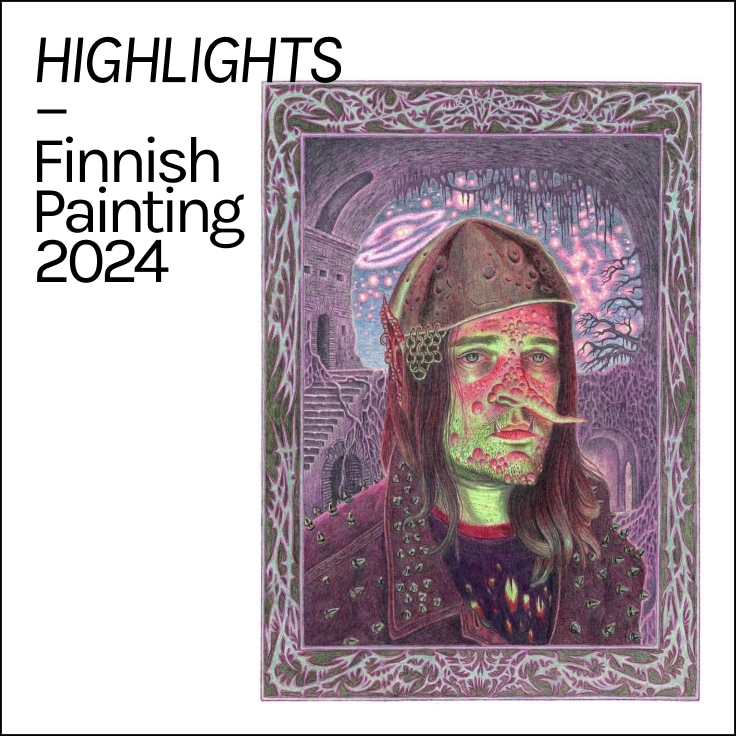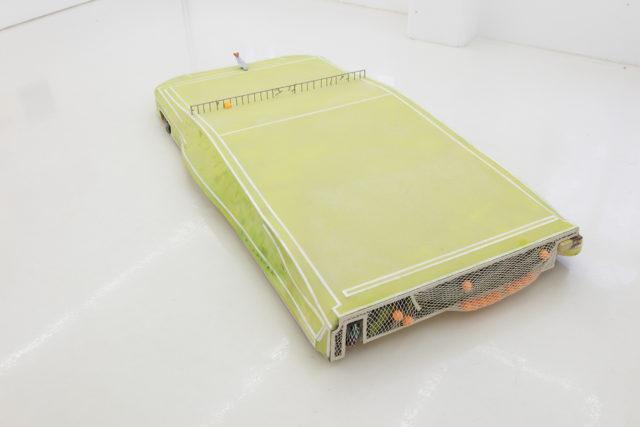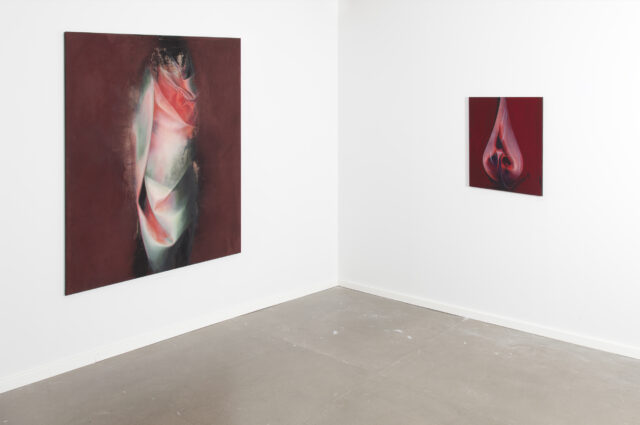The weeks surrounding CHART art fair and ENTER Art Fair (29 August – 1 September, 2024) offer an exceptional opportunity for the international art community to enjoy a focussed interest in Nordic talent as the world’s leading arts professionals, collectors, enthusiasts and collaborators look to the wider Nordic region for introductions to the artists being showcased at the fair and in galleries, institutions and ateliers around Copenhagen and beyond.
To complement this focus on Nordic talent, The Finnish Painters Project has commissioned Mamie Beth Cary and Claire Mary Anne Gould to co-select 10 of their artists to inspire you beyond the fair’s radar. Mamie Beth Cary is Director at von Bartha in Copenhagen, and Claire Mary Anne Gould has more recently been an institutional curator at Kunsten Museum of Modern Art Aalborg and HAM Helsinki Art Museum.
This selection, titled HIGHLIGHTS, is intended to act as a prompt for you, whatever your role or interest is within the international art community, to explore more yourself and to delve into contemporary Finnish Painting. As you will find, there are many talented artists on this website worthy of your endorsement, too.
Between us we discussed and deliberated, contested and compromised to co-select the 10 contemporary Finnish artists mentioned below, amongst them are four generations of painters spanning almost five decades.
It is an impossible task to choose 10 artists from over 100 that are part of The Finnish Painters Project, who reflect the broadest definitions or understandings of diversity, both including their artistic practices and conceptual approaches. We have therefore chosen to highlight artists whose contemporary practices’ both continue to build on and enrich traditional painting methods; those that are creating new gestures and expressions in the medium of painting; others which look to expand on the influences of painting whilst embracing new media; as well as those engaging with painting as a conceptual tool.
Thus methods and mediums also account for diversity – ranging from photography as a preparatory tool, to waste material and grounded pigments as root material sources. And whether figurative or abstract, painting can be proposed for open space on and off of the walls, out of frames or purposefully encased, venerated on pedestals and in public spaces.
From paint entwined with textiles and objects woven into sculptural painting, the definition of the medium of painting is also reframed. Subjects span the preoccupations of the personal and human condition, including bonds of friendships, families and sexuality, identity and inequality, curiosity and fear, memories and trauma, chaos and compassion, hope and healing, the blurred and broken, between fake and reality. Amongst them too, the fantastical and playful.
Below you can read our concise reflections on each artist’s works. Though, as mentioned above, our selected 10 offers a mere appetizer of the richness of this Finnish painters’ painting palette.
To enjoy, endorse and select your own – click this way…
Mamie Beth Cary and Claire Mary Anne Gould
About Mamie Beth Cary
Mamie Beth Cary (b. 1988) is the Director of von Bartha in Copenhagen, and has since 2021 overseen the gallery’s artistic programming. As the first international gallery to open in the Scandinavian city, she is responsible for the gallery’s dedicated engagement with the local and international art community, which has resulted in exhibitions, events, tours, and special
commissions. Located in the 75 m2 historic lighthouse in the vibrant neighborhood of the Carlsberg City District, she has transformed the gallery space into a creative hub for contemporary art.
Together with Hester Koper and Caroline Bøge, Mamie is the co-founder of WITA (Women Interacting Through Art), an initiative in Scandinavia that provides a platform for leading women and non-binary individuals to come together, enjoy a diverse and engaging program through art, and share and learn from each other‘s experiences.
Born in London, she holds a combined honors degree in History of Art and English Literature from the University of York. After graduating, she worked for artists, galleries, publications, and art fairs, including Frieze, Damien Hirst, Isaac Julien, and Ryan Gander. She moved to Copenhagen in 2016, taking up the role as Head of Artistic Programming at Chart Art Fair and Director of the gallery Andersen’s Contemporary. She lives with her husband and daughter in Vesterbro.
About Claire Mary Anne Gould
Claire Mary Anne Gould (b. 1973) is a Curator with over 20 years experience working in the arts, both an independent and instuítutional curator.
From 2005-2019, she was Curator at Helsinki Art Museum (HAM), curating group and solo exhibitions of Finnish and international artists, including monographic exhibitions with Yayoi Kusama (2016) and Gilbert & George (2018). More recently she was Curator at Kunsten Museum of Modern Art in Aalborg, Denmark working with international artists such as Shara Hughes, John Körner and Larissa Sansour & Sören Lind. Previous employment has included the British Council, Helsinki, Hamburger Bahnhof/Museum der Gegenwart, Berlin, and CHART art fair, Copenhagen.
Claire grew up in the UK where she studied a BA (Hons) in Fine Art at Newcastle University, completed a Master diploma in Economics from the Technische Universität, Hamburg, a Master in Arts Management from the Sibelius Academy, Helsinki, and in June 2024 graduated with an MA in Curating from Aarhus University.
HIGHLIGHTS artists
Henna Aho, Elina Autio, Mathilde Enegren, Kaija Hinkula, Tiina Heiska, Tuomo Laakso, Rauha Mäkilä, Jussi Niva, Elsa Salonen, and Joel Slotte.
HENNA AHO (b. 1977)
Beyond the seemingly cryptic titles, Aho’s object-based works act like diaries of her daily life, documenting the content of her time and existence, whilst freezing precious moments and expressing personal experiences and memories. Interweaving diverse materials and ready-made objects as paint strokes, Aho maintains a painter’s perspective, entwining diverse emotions within complex layers and compositions, capturing important constants – that offer her comfort in everyday life counteracting anxieties and other sensibilities. The chaos and healing within these threads go beyond the textiles themselves. In the works, seemingly incongruous objects and materials meet and merge in poetically tactile ensembles, playfully caught up together, in a kind of lifejacket to keep one afloat. Beyond this, her works experiment with the medium of painting, expanding it as both medium, process and subject. Weaving too serves both as a conceptual current and medium as materials, processes or objects are partially exposed, let go of, or even absent.
ELINA AUTIO (b. 1985)
Autio’s sculptural paintings create punctuation in a visual poetry, challenging our assumptions of the functions of surfaces and frames. This conceptual disruption translates in the forms of her works – by her masterful techniques of bending or creating bends. A painted surface may serve to hide a join and a process, or act as an emotional protective layer, whereas skeletal cross-sections of wood reveal inner feelings, physical imperfections, limitations or vulnerabilities. Her works also engage us in other perspectives, physically, as we view them like a slice of a sculpture, from the side or from above. Surrendering to her material is a method, and more recently this has included letting go of the form of her works to her audience – becoming both the creator and viewer of her practice. Her most recent works, a collective of painterly pedestals, explore the significance of human emotions, from warmth to melancholy. Autio’s accomplished choice of palette is intuitive and explores the nuances of colour play creating the illusion of light and shadow, reminding us of that which remains deeper, not viewable, beneath the surface.
MATILDA ENEGREN (b. 1989)
Enegren’s previous practice embraced a Zeitgeist, taking us on almost photographic journeys in public spaces, and reflecting the deep focus and absorption of both our individual selves and our group dynamic selves. Enegren’s expert knowledge of her medium, and recent investigations into the very materials that make up watercolour, the strength of different pigments and how they respond, interact, overlay, have resulted in an exciting development of her subject from figurative to abstract figuration. Colour also plays a central role in the new works, as translucency, but also creating remarkable depth and volume is achieved through layering. Her newest works also reflect her ongoing fascination with landscape and places. Some reveal multiple horizons, whilst others mysterious botanical-like forms combining both naturalistic and abstract forms. These works are partially existential – expressing a state of comfort and hope after the winter months, when something seemingly familiar may blossom from the most elusive of forms.
TIINA HEISKA (b. 1959)
Heiska is a master in the medium of oil painting, deftly using her excellent technique as a vehicle to confront questions of gender, desire, female identity, and childhood memories. With compositions that are constructed from the artist’s own photographic material, within which she also appears as her own model and subject, there is a certain reference to 19th Century Realism and the ‘male gaze’, however, here it is from a decisively female perspective. Heiska cleverly includes nostalgic ephemera such as antique roses and old-fashioned clothing within blurred environments and fragmented interiors, as if to offer the audience a view through a camera’s viewfinder to a paused scene or that of an anticipated happening in a timeless landscape. Some of her current practice experiments with the absence of human figures in landscapes or indecipherable surroundings enveloped by a sense of movement and light, where luminous and even tones oscillate both controlled brushstrokes and collateral marks or traces born from the paints own resolve.
KAIJA HINKULA (b. 1984)
The sculptural and architectural expressions of Hinkula’s practice act as spatial extensions of the artist’s investigation into the medium of painting. Precisely executed, Hinkula creates fantastically uncanny scenes that are inhabited by abstract yet humorous characters. There is a specific colour palette applied to each presentation of her work, which creates a stage-like scene, where her works as protagonists dominate. In her most recent practice, she investigates the theme of the garden, a vision and breeding ground for new ideas and utopias. The garden symbolises hope, the imagining of a new world, full of potential and possibilities in which her expanded paintings, sculptures and ready-mades celebrate nature’s order and chaos, appearance and disappearance as well as blossoming and decay, even joy and horror.
TUOMO LAAKSO (b. 1980)
Tuomo Laakso is occupied by the tradition of still-life painting, focussing on inanimate self-made subjects which he constructs from found and waste-materials, caught in a specific moment. His final works unfold out of intuitive but also complex and controlled processes of sensory experiences, and of selection and creation. Playing with the conventional subjects of still-life painting, which traditionally displayed wealth and luxury, Laakso instead chooses to depict seemingly abandoned scenes of solitude and decay. He generously invites his viewers into private moments between him and his constructed subjects as witnesses to his own reflections of intimacy, stillness, fear and humour. Laakso paints his subjects faithfully but, like vague memories, the protagonists rarely represent what they may first appear to be. Like the pause between an intake and exhalation of breath, there is a weightlessness and beauty to Laakso’s compositions which is enhanced by the artist’s decision to avoid artificial environments and electric lights. Instead he depicts the natural light falling on his subjects at any given time of day and year, capturing not fragility of materials but also the passage of time in which his works evolve.
RAUHA MÄKILÄ (b. 1980)
Rauha Mäkilä’s acrylic and oil paintings investigate humanness through scenes of her daily life – awarding value to everyday moments with her family, friends, pets, and intimate domestic surroundings and even her own studio practice. More recent works reference scenes from art exhibitions – depicting both engaged and exhausted family members. Despite her characters at first appearing disengaged from us, with little eye contact, we are welcomed into their lives, to share their space, their experiences, and warmth. Central to Mäkilä’s works is her exceptionally refreshing colour-saturated palette which pulls us consistently in and out – from subtle strokes of neon to surfaces of more sombre shades. Mäkilä has a unique approach to spatial compositions too – seemingly impassable dark spaces, tilted floors and flattened confrontational corners are nonetheless equally as alluring as her plate of curled up sausages in the foreground.
JUSSI NIVA (b. 1966)
Jussi Niva’s practice challenges the traditional method of painting, creating spatial experiences which are at the same time jarring and aesthetic. Niva’s precisely executed cut and folded forms push out into the exhibition space, presenting a duality between the abstract, two-dimensional painted surfaces that exist on his three-dimensional, wall-based sculptures. Niva’s canvas is solid wood, yet the geometric winding pathways down which we are led play like folded origami paper, where surfaces abruptly end, colliding to create instantaneous friction and an interruption to the route expected, like twists of fate. Experiencing these works is to decode and unfold the physical constructions and allow for a new rhythm of seemingly impossible spatial interventions.
ELSA SALONEN (b. 1984)
Elsa Salonen’s practice examines painting beyond the brush, exploring cycles of life and death through colour and materiality. Science, animism, alchemy, botany, as well as Finnish nature and folklore unfold in her conceptual works and installations. Her most recent works include medicinal plants known for inducing sleep. Colour pigment is central to her work, signifying the energy or presence of life, laboriously sourced, extracted and distilled from flowers, plants and algae, complemented by her methods of bleaching, symbolising the absence of colour and death. The artist’s self-made pigments become her collaborators defining the conceptual message of each part of her work, that are equally material and method in her practice. Throughout her oeuvre we appear to witness a state of experimentation in her laboratories of sorts. Through Salonen’s meticulously planned installations we sense the possibilities too of a preservation or offering of colour and pigment back into a cycle of new energy or forms of life.
JOEL SLOTTE (b. 1987)
Joel Slotte’s practice spans drawing, painting and ceramics inspired by diverse cultural and art historical references, including symbolism, jewellery and even mediaeval book illuminations. Often portraying an altar ego, his close friends, or even auto(fictional) characters, his protagonists often appear lost in what he describes as emotional in-between states, a kind of self-reflection looking beyond our own gaze. In referencing subcultures and fashion, their outerwear – whether a band t-shirt or real armour – shields them from their vulnerabilities and judgement of others. Between real life and fiction, the absurd or surreal in the everyday is explored and exposed, often with humour. Equally, seemingly mundane moments shared with friends are captured as special memories typically surrounded by the Finnish forest. Yet it is the imaginary, dark, fantasy world that offers a respite from the present. Some of his most recent works experiment with still-life painting, inspired by Dutch vanitas paintings.



